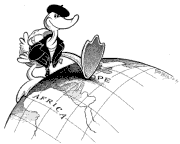A Beginner's Guide to Effective Email
Gestures
Kaitlin Duck SherwoodNot only does text lack the emotional cues that vocal inflection gives, text lacks cues from body language. There is no twinkling of the eyes to say you are kidding, no slapping the back of your hand in your palm to show urgency or frustration, no shoulders slumping to display discouragement.
While you are unable to accompany your words with hand or facial gestures, there are several textual stand-ins for gestures.
Smileys
A facial gestures can be represented with what is called a "emoticon" or "smiley": a textual drawing of a facial expression. The most common three are:-) ;-)and
:-((To understand these symbols, turn your head counter-clockwise and look at them sideways. You should see little faces.)
While people will have slightly different interpretations of the exact difference between the upper two, my personal opinion is that the upper one means more "I'm happy" and the lower one means more "I think I'm being funny". The last one is pretty universally understood as "I'm sad".
Typical examples:
Hey, guess what - I got the left-handed thromblemeister spec done ahead of time! :-) I'm on my way to fame and fortune now! ;-)The second smiley, the ;-), indicates that you don't really believe that your boss will give you that big raise. It is similar to but not as fierce or trendy a rebuttal as a "NOT!" appended to the end of a sentence:
Hey, guess what - I got the left-handed thromblemeister spec done ahead of time! :-) I'm on my way to fame and fortune now - NOT!There are a wide range of ASCII gestures available to you, from ill (%^P) to angry (>:-<) to astonished (:-o), limited only by your imagination. There are whole Smiley Dictionaries out there if you are feeling uncreative. (Note: I think that some of the Smiley Dictionary definitions of the basic smileys aren't a totally accurate reflection of the way I see smileys used, but your mileage may vary.)
Note that Japanese emoticons are quite different.
Pause Equivalents
Imagine that you ask someone if you can turn the knob up to ten and a half. Suppose he says, "Well", then pauses for a long time, scratches his head, looks down at the floor, winces, grits his teeth, and says again, "Well", then pauses and says, "It might not explode". You'd get a sense of just how bad an idea it would be, while the text:Well, it might not explode.gives less information. I like to use lots of whitespace and typed-out vocalizations of "I'm thinking" sounds, as follows:
Weeeellllll.... errr hem. Wellll, it *might* not explode.You can also use whitespace to make it more clear which words belong to which clause. For example, the following is very difficult to parse
Did you want to use a left-handed thromblemeister or a right-handed one with a half-twist or a Jackadoody brocket?You could instead haul out your high school notes on outlines:
Did you want to use 1. a left-handed thromblemeister or 2. a right-handed one with a a. half-twist b. Jackadoody brocketThe only problem with using an outline like this is it invites people to send back messages that have nothing in them but the code for the answer they want, such as
2b.To avoid that, you can use a structure like:
Did you want to use a left-handed thromblemeister or right-handed one with a half-twist or right-handed one with a Jackadoody brocket?This invites people to cut-and-paste the exact, full thing they want:
> a right-handed one with a Jackadoody brocket?
Creative Punctuation
I tend to use a lot of punctuation in what I call "comic book style". Instead of saying:I am very confused and a little upset. Why did you give my report to Jack instead of Jill?I would probably say:
?!?! Why did you give my report to Jack instead of Jill?!?The question mark is kind of shorthand for a furrowed brow or a "huh?". The exclamation mark is shorthand for amazement and possibly a scowl. The two together seem to mean astonishment.
There is a long and proud tradition of using punctuation as a place holder for swearing, e.g. That #%&#$(*! You will also sometimes see an asterisk in place of important letters, usually the vowel, e.g. That son of a b*tch! or That son of a b****! or very rarely That s*n of a b*tch!. (In actual practice, this form of self-censorship is rare; it is more common for people to either use the whole word or omit it completely.)
Go on to Status
Go back to the beginning
Go back to Intonation
Created 10 Dec 1994
Modified 29 Oct 1998
Fixed typo 24 Feb 2000
Beautified page 23 May 2001
More beautification, plus added link to Wikipedia Emoticon 23 June 2007
Please see the copyright notice.
